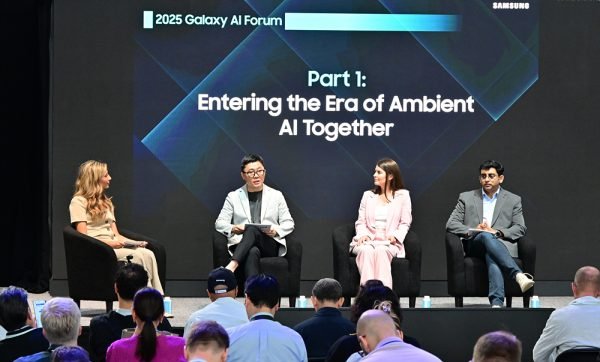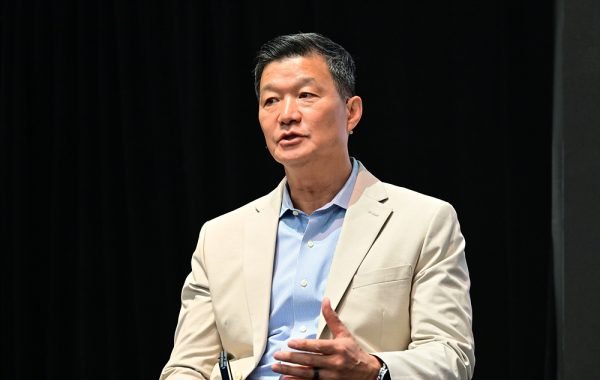Tools & Platforms
Industry Leaders Chart the Future of Mobile Innovation at Galaxy Tech Forum

At Galaxy Unpacked 2025 on July 9, Samsung Electronics unveiled its latest Galaxy Z series devices and wearables — pushing the boundaries of foldable design and connected wellness experiences. These innovations mark the next step in the company’s mission to deliver meaningful, user-centered technology, with Galaxy AI and digital health emerging as key pillars of the journey ahead.
To explore these themes further, Samsung hosted two panels at the Galaxy Tech Forum on July 10 in Brooklyn. Samsung Newsroom joined industry leaders and executives to examine how ambient intelligence and advanced health technologies are shaping the future of mobile innovation.
(Panel One) The Next Vision of AI: Ambient Intelligence
(From left) Moderator Sabrina Ortiz, Jisun Park, Mindy Brooks and Dr. Vinesh Sukumar
The first panel, “The Next Vision of AI: Ambient Intelligence,” explored how multimodal capabilities are enabling the continued evolution of AI in everyday life — blending into user interactions in ways that feel intuitive, proactive and nearly invisible. Panelists discussed the smartphone’s evolving role, the importance of platform integration and the power of cross-industry collaboration to deliver secure, personalized intelligence at scale.
Jisun Park, Corporate Executive Vice President and Head of Language AI Team, Mobile eXperience (MX) Business at Samsung Electronics, opened the conversation by reflecting on Galaxy AI’s rapid adoption. Since the launch of the Galaxy S25 series in January, more than 70% of users have engaged with Galaxy AI features. He then turned the discussion to the next frontier, ambient intelligence — AI that is deeply personal, predictive and ever-present.

Jisun Park from Samsung Electronics
Samsung sees ambient intelligence as AI that is so seamlessly integrated into daily life it becomes second nature. The company is committed to democratizing Galaxy AI to 400 million devices by the end of 2025.
This vision builds on insights from a yearlong collaboration with London-based research firm Symmetry, which revealed that 60% of users want their phones to anticipate needs without prompts — based on daily habits.
“Some see AI as the start of a ‘post-smartphone’ era, but we see it differently,” said Park. “We’re building a future where your devices don’t just respond — they become smarter to anticipate, see and work quietly in the background to make life feel a little more effortless.”
Mindy Brooks, Vice President of Android Consumer Product and Experience at Google, discussed how multimodal AI is moving beyond reactive response to deeper understanding of user intent across inputs like text, vision and voice. Google’s Gemini is designed to be intelligently aware and anticipatory — tuned to individual preferences and routines for assistance that feels natural.

Mindy Brooks from Google
“Through close collaboration with Samsung, Gemini works seamlessly across its devices and connects with first-party apps to provide helpful and personalized responses,” she said.
Dr. Vinesh Sukumar, Vice President of Product Management at Qualcomm Technologies emphasized that as AI becomes more personalized, there is more information than ever that needs to be protected.
“For us, privacy, performance and personalization go hand in hand — they’re not competing priorities but co-equal standards,” he said.

Dr. Vinesh Sukumar from Qualcomm Technologies
Both Brooks and Dr. Sukumar reinforced the importance of tight integration across platforms and hardware.
“Our work with Samsung prioritizes secure, on-device intelligence so that users know where their data is and who controls it,” said Dr. Sukumar.

The AI panel at Galaxy Tech Forum
Moderator Sabrina Ortiz, senior editor at ZDNET, closed the session with a discussion on AI privacy. Panelists agreed that trust, transparency and user control must underpin the entire AI experience.
“When it comes to building more agentic AI, our priority is to ensure we’re fostering smarter, more personalized and more meaningful assistance across our device ecosystem,” said Brooks.
(Panel Two) The Next Chapter of Health: Scaling Prevention and Connected Care
The second panel, “The Next Chapter of Health: Scaling Prevention and Connected Care,” focused on how technology can bridge the gap between wellness and clinical care — making health insights more connected, proactive and usable for individuals, healthcare providers and digital health solution partners. Panelists explored how the convergence of clinical data, at-home monitoring and AI is reshaping the modern healthcare experience.

(From left) Moderator Dr. Hon Pak, Mike McSherry, Dr. Rasu Shrestha and Jim Pursley
Health data is often siloed across systems, resulting in inefficiencies and gaps in care. Combined with rising rates of chronic illness, an aging population and ongoing clinician shortages, the result is a system under pressure to deliver timely, effective care.

Dr. Hon Pak from Samsung Electronics
“Patients and consumers around the world are asking us to hear them, to know them, to truly understand them,” said moderator Dr. Hon Pak, Senior Vice President and Head of Digital Health Team at Samsung Electronics. “And I believe this is the opportunity we have with Samsung, Xealth and partners like Hinge and Advocate. Together, we are creating a connected ecosystem where healthcare can truly make a difference — not just in the life of a patient, but in the life of a person.”
Samsung is addressing this challenge through technological innovation and its recent acquisition of Xealth, a leading digital health platform with a network of more than 500 hospitals and 70 digital health solution providers. Through Xealth, Samsung plans to connect wearable data and insights from Samsung Health into clinical workflows — delivering a more unified and seamless healthcare experience.

Mike McSherry from Xealth
“This , plus your devices — the watch, the ring — are going to replace the standalone blood pressure monitor, the pulse oximeter, a variety of different devices,” said Mike McSherry, founder and CEO of Xealth. “It’s going to be one packaged solution, and that’s going to simplify care.”
This collaboration is designed to empower hospitals with real-time insights and help prevent chronic conditions through early detection and continuous monitoring with wearable devices.

Dr. Rasu Shrestha from Advocate Health
“The reality is that with all of the challenges that exist in healthcare, it is not any one entity that can heroically go in and save healthcare. It really takes an ecosystem,” said Dr. Rasu Shrestha, Executive Vice President and Chief Innovation & Commercialization Officer at Advocate Health. “That’s part of the reason why I’m so excited about Xealth and Samsung — and partners like us — really coming together to solve for this challenge. Because it is about Samsung enabling it. It’s more of an open ecosystem, a curated ecosystem.”
The panel spotlighted the growing shift from hospital-based care to care at home — and the opportunities enabled by Samsung’s expanding ecosystem of connected devices. Data from wearables, including those equipped with Samsung’s BioActive Sensor technology, can provide high-quality input for AI-driven insights.
Paired with Samsung’s SmartThings connectivity and wide portfolio of smart home devices, the company is uniquely positioned to support remote health monitoring and treatment from home.
AI is expected to play a role in reducing clinician workload by streamlining administrative tasks and surfacing the most relevant insights at the right time. Platforms like Xealth offer users a personalized, friendly interface to access necessary information from one place for a more connected healthcare experience.
Tools & Platforms
A Strategic Inflection Point for AI and Corporate Alignment

The Trump administration’s recent AI Action Plan and the high-profile Tech Summit in the newly renovated White House Rose Garden mark a pivotal recalibration of U.S. technology policy. By aligning corporate priorities with federal deregulatory ambitions, the administration is reshaping the investment landscape for artificial intelligence. This analysis explores the strategic implications of this alignment, focusing on how Trump’s policies are redefining risk, reward, and global competitiveness in the AI sector.
Deregulation as a Catalyst for Innovation
The administration’s AI Action Plan, unveiled on July 23, 2025, prioritizes accelerating innovation through regulatory rollbacks. Over 90 federal policy actions aim to remove barriers to AI development, including streamlined permitting for data centers and reduced environmental restrictions on infrastructure projects [2]. For instance, the use of categorical exclusions under the National Environmental Policy Act (NEPA) now expedites data center construction, a move that could unlock billions in private investment. According to a report by Bloomberg, this deregulatory push has already spurred a 20% surge in capital expenditures by hyperscale cloud providers in Q3 2025 [4].
The emphasis on “ideological neutrality” in federal AI procurement, formalized via the “Preventing Woke AI” executive order, further signals a shift in priorities. By mandating that AI models adhere to “truth-seeking” principles, the administration is fostering a market environment where companies like Nvidia and Microsoft—whose open-weight models align with these guidelines—stand to gain significant federal contracts [5]. This creates a dual opportunity: firms that adapt to the new framework may secure lucrative government partnerships, while those lagging in compliance risk marginalization.
Infrastructure and Export-Driven Growth
A cornerstone of the AI Action Plan is the push to build domestic AI infrastructure, including semiconductors and data centers. The administration’s call for a single federal standard—replacing a patchwork of state-level regulations—has already influenced investor behavior. Morgan Stanley notes that tech stocks in the S&P 500 accounted for 80% of the index’s gains in 2025, with AI-related equities outperforming by a 15-point margin [4]. This trend is amplified by the administration’s focus on exporting the “American AI Technology Stack” to allies, a strategy that could expand markets for U.S. firms while countering Chinese influence [3].
However, this infrastructure push is not without risks. Critics warn that reduced environmental oversight could lead to long-term costs, such as energy grid strain and ecological damage. Yet, the administration’s commitment to modernizing the power grid—part of its AI Action Plan—suggests a calculated effort to mitigate these concerns through public-private partnerships [5].
Corporate Alignment and Investor Sentiment
The Trump administration’s summit with tech leaders like Mark Zuckerberg, Tim Cook, and Bill Gates underscores a deliberate effort to harmonize corporate and federal agendas. This alignment has translated into investor confidence: since the plan’s announcement, the S&P 500’s AI-driven gains have surged, with Nvidia’s market cap alone rising by $1.2 trillion in six months [1].
Yet, this optimism is tempered by divergent regulatory pressures. While the federal government promotes deregulation, states like California and New York have maintained stricter AI oversight. This creates a “regulatory arbitrage” scenario, where companies may prioritize federal-aligned strategies to access funding and contracts, even if it means sidestepping state-level safeguards [2]. For investors, this duality presents both opportunities (e.g., scalable AI deployments) and risks (e.g., reputational damage from perceived ethical lapses).
Strategic Implications for Investors
The administration’s focus on global AI leadership—through alliances with like-minded nations and export controls—positions U.S. tech firms to dominate emerging markets. However, the lack of detailed implementation timelines in the AI Action Plan raises questions about execution risks [6]. Investors should prioritize companies with robust supply chains and geopolitical agility, such as semiconductor manufacturers and cybersecurity firms.
Conversely, sectors reliant on state-level regulations (e.g., healthcare AI with privacy mandates) may face headwinds. The administration’s discouragement of state-level AI rules—via funding decisions tied to regulatory climates—could force firms to choose between compliance and profitability [1].
Conclusion
Trump’s Tech Summit and AI Action Plan represent a strategic inflection point, redefining the interplay between corporate innovation and federal policy. While deregulation and infrastructure investment offer clear tailwinds for tech stocks, investors must navigate the tension between short-term gains and long-term risks. The administration’s emphasis on ideological neutrality and global competitiveness suggests a market environment where alignment with federal priorities will increasingly dictate success. For now, the data—and the market—seem to be on the administration’s side.
Source:
[1] The Trump Administration’s 2025 AI Action Plan [https://www.sidley.com/en/insights/newsupdates/2025/07/the-trump-administrations-2025-ai-action-plan]
[2] Tech companies want to move fast. Trump’s ‘AI Action Plan’ [https://www.latimes.com/business/story/2025-07-23/trump-unveils-ai-action-plan]
[3] Trump AI Summit Targets Hardware as Key to US Supremacy [https://www.bloomberg.com/news/newsletters/2025-07-28/trump-ai-summit-targets-hardware-as-key-to-us-supremacy]
[4] Q2 2025 Market Perspective [https://altiumwealth.com/blogs/altium-insights/q2-2025-market-perspective]
[5] Trump Administration Unveils AI Action Plan with … [https://www.mayerbrown.com/en/insights/publications/2025/07/trump-administration-unveils-ai-action-plan-with-implications-for-innovation-infrastructure-and-global-tech-competition]
[6] Inside Trump’s Ambitious AI Action Plan | Stanford HAI [https://hai.stanford.edu/news/inside-trumps-ambitious-ai-action-plan]
Tools & Platforms
AI, lasers and chips: the science and tech of China’s military parade

China’s military parade on Wednesday – featuring the latest AI-powered uncrewed vehicles, laser weapons and missiles – signalled an arms race fuelled by scientific and technological advances.
Artificial intelligence, optics and physics and information technologies have underscored how innovations will shape the future of modern warfare, paving the way for futuristic intelligent systems.
“The parade featured unmanned intelligent systems, underwater combat units, cyber and electronic forces and hypersonic weapons, highlighting the growing capacity of the People’s Liberation Army (PLA) to harness emerging technologies, adapt to the evolving character of warfare, and prevail in future conflicts,” state broadcaster CCTV said.
The weapons on parade featured a “high level of informatisation, intelligence and practical combat capability, showcasing the military’s combat abilities, capabilities in new domains and strong strategic deterrence”, Dong Yongzai, a researcher at a centre under Beijing’s Academy of Military Science, told CCTV.
AI-powered equipment and vehicles
The parade showcased a variety of AI-powered uncrewed equipment.
The land combat formation showed vehicles that can perform reconnaissance, assaults, mine and bomb defusing and squad support, according to CCTV.
Tools & Platforms
Janus Health Joins Cipher Collective as Revenue Cycle Technology Provider in AI-Enabled Healthcare Initiative – geneonline.com
-

 Business5 days ago
Business5 days agoThe Guardian view on Trump and the Fed: independence is no substitute for accountability | Editorial
-
Tools & Platforms3 weeks ago
Building Trust in Military AI Starts with Opening the Black Box – War on the Rocks
-

 Ethics & Policy1 month ago
Ethics & Policy1 month agoSDAIA Supports Saudi Arabia’s Leadership in Shaping Global AI Ethics, Policy, and Research – وكالة الأنباء السعودية
-

 Events & Conferences4 months ago
Events & Conferences4 months agoJourney to 1000 models: Scaling Instagram’s recommendation system
-

 Jobs & Careers2 months ago
Jobs & Careers2 months agoMumbai-based Perplexity Alternative Has 60k+ Users Without Funding
-

 Education2 months ago
Education2 months agoVEX Robotics launches AI-powered classroom robotics system
-

 Funding & Business2 months ago
Funding & Business2 months agoKayak and Expedia race to build AI travel agents that turn social posts into itineraries
-

 Podcasts & Talks2 months ago
Podcasts & Talks2 months agoHappy 4th of July! 🎆 Made with Veo 3 in Gemini
-

 Podcasts & Talks2 months ago
Podcasts & Talks2 months agoOpenAI 🤝 @teamganassi
-

 Education2 months ago
Education2 months agoMacron says UK and France have duty to tackle illegal migration ‘with humanity, solidarity and firmness’ – UK politics live | Politics


